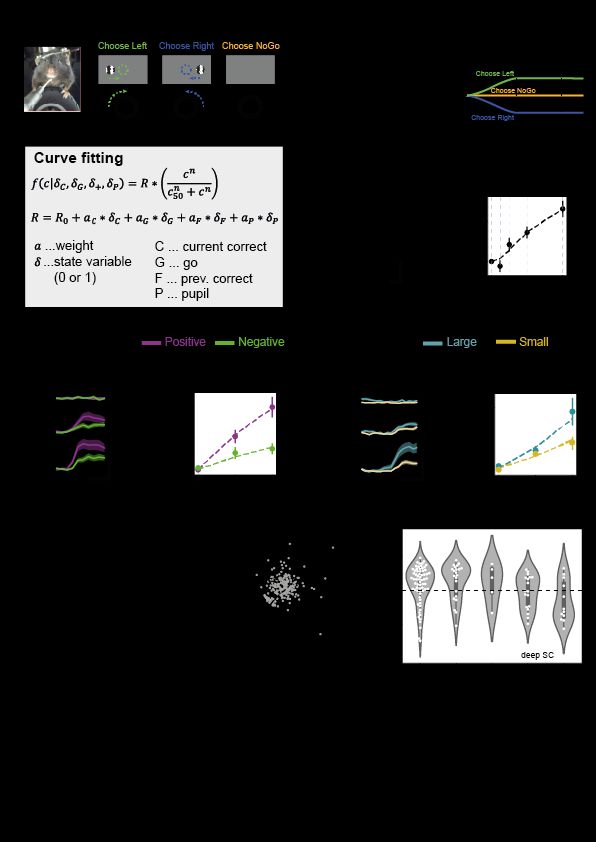The superior colliculus (SC) is a major recipient of visual input in the mouse and controls innate approach and avoidance behaviours. Neurons in the superficial SC (sSC), which receives direct input from the retina, do not only process visual stimuli, but are also modulated by the animal’s running speed and pupil-linked arousal, like modulations observed in the primary visual cortex. While these observations were made during passive viewing of visual stimuli, a major purpose of vision is to guide behaviour. We therefore asked whether, in the context of a behavioural task, visual activity in the sSC is modulated by states or variables other than pupil-linked arousal.
We trained mice to perform a visual detection task, where they needed to detect a stimulus of varying contrast in the left or right visual field and then interactively move the stimulus towards the centre of the visual field (Panel A). If no stimulus was presented, the mice had to refrain from moving the stimulus. Each trial was divided into distinct periods: a quiescent period with no stimulus, an open loop period, in which the mouse should hold the wheel steady, and a closed loop period, in which the mouse can move the stimulus. These were followed by positive or negative feedback (Panel B). We then imaged the sSC of 4 well-trained mice over 16 sessions, using two-photon calcium imaging.
We quantified the contribution of various task events to the neuronal visual response by their relative contribution to the gain of a hyperbolic division function (p<0.05, shuffle test; Panels C,D). We discovered a population of neurons that were positively modulated by previous reward (Panel E). Similarly to previous studies, we also found that pupil-linked arousal modulated the visual responses of sSC neurons, either positively or negatively (Panel F).
Our evidence shows that these two factors, pupil and feedback modulation, are independent. First, the pupil size during stimulus presentation does not change between trials following positive or negative feedback (p=0.76, t-test; Panel G). Second, the modulation of the gain by the two factors is independent (p<0.001;t-test).Panel H).
Lastly, using Neuropixels, we validated our results by recording from the entire depth of the SC. These experiments revealed that the majority of reward modulated neurons were found in the sSC rather than in deeper layers of the SC (Panel I).
Our findings show that visual responses of sSC neurons are strongly influenced by two independent state variables: pupil-linked arousal and previous reward. Future studies may reveal how these non-visual modulations help downstream processes in guiding behaviour.
Sensory Signals (The Royal College of Physicians, London, UK) (2022) Proc Physiol Soc 50, C01
Oral Communications: Reward modulates visual responses in mouse superior colliculus independently of arousal
Liad J. Baruchin1, Sylvia Schröder1
1University of Sussex, Falmer, United Kingdom
View other abstracts by:
Where applicable, experiments conform with Society ethical requirements.

